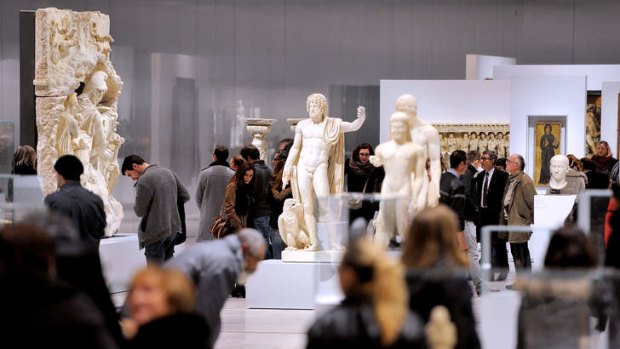
Culture for all...the Louvre's first provincial base in southern France.Credit: Getty Images
The Louvre is taking art out of Paris, writes Anthony Peregrine.
Until now, you went to Lens, 180 kilometres north of Paris, for slag heaps and other fine mining memories. You might also have used it as a base from which to see Great War battlefields. What you didn't get much of was world-class culture.
This is precisely why the place has opened an art gallery of astounding breadth and brio, containing works from across the history of human creativity. In the year's biggest French cultural initiative, the Louvre has broken out of Paris to establish its first provincial base on a disused colliery site hemmed in by housing estates.
The Louvre-Lens opened on December 12. The €150 million ($185 million) building is of deceptive simplicity, a succession of four connected rectangles and a square, all in aluminium and glass. It has been kept long and low - a single storey - to avoid crushing locals with worthiness. The Japanese architects want the neighbours to come in, not stay outside, awestruck.
"The idea is to bring culture to people who are distant from it, to say that culture is for them, too," says the museum director, Xavier Dectot.
The other idea is to boost the economy of France's hardest-hit region. The model here is the Guggenheim in Bilbao. "We're already modifying Lens's image, even before we open," Dectot says.
It's a hell of a trick to pull off. Mention Lens to French people and they think muck, not masterpieces. Granted, the 19.4-hectare park around the museum wasn't ready for the opening. But the entrance hall, all light, space and glass, is terrific.
So to the main attraction, the great Gallery of Time. Here is a vast space, about 122 metres by 24 metres, with reflective aluminium walls on which nothing at all hangs. Instead, the 205 works, chosen from all eight of the Louvre's Parisian departments, are disposed on little freestanding walls and "exhibit islands". They cover the gamut of world art, from the fourth millennium BC to about 1850. From the raised area at the front of the gallery, you have a sweeping overview of what man has done best for 6000 years. Then you plunge in.
The approach is chronological along the length of the building with, across the width, what was happening in different countries and civilisations at any given time. Cross-cultural references were never easier or more entrancing. You weave about, comparing, say, a simple Cycladic feminine idol with much fancier stuff going on in Egypt at the same epoch. You note different depictions of the human body, and their evolution, in classical times.
It makes for the most stimulating, instructive show I've seen for a long time, possibly ever. Whatever your level of artistic knowledge - mine's low - you're grasping things not even guessed at before. You can't do that at Louvre HQ, where all the works are tidied away in their own departments and never meet. Here, they're observing one another and, of course, being observed.
Beyond, a second, glass-walled gallery amplifies the time-related themes in the main show. Shows in both these galleries will be in place for five years, with about 15 per cent of the works changing annually. Meanwhile, the third gallery will have exhibitions lasting three to four months, opening with a magnificent introduction to the Renaissance, showcasing works from the Louvre and elsewhere.
For some time, Dectot has had teams out and about in the Lens region, knocking on doors and bidding locals not to be intimidated: the new Louvre really is for them. "The main message is that this is an open place of pleasure," Dectot says. "Don't come here to be taught, but for enjoyment and delectation."
The stream of human genius can, in short, be a joy for all. And it takes only a morning or an afternoon. Getting a similar overview in the Parisian Louvre would take a couple of years of intensive study. The Louvre-Lens is a magnificent short cut many of us crave.
Telegraph, London
Sign up for the Traveller Deals newsletter
Get exclusive travel deals delivered straight to your inbox. Sign up now.